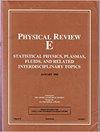Escaping dynamics of relativistic protons in the Earth's magnetosphere.
IF 2.4
3区 物理与天体物理
Q1 Mathematics
引用次数: 0
Abstract
In this work, we study the motion of protons under the influence of the Earth's magnetic field. We investigate the dynamics and topology of invariant spatial regions in two magnetic field models, namely, the dipolar and Luhmann tail configurations. In both cases, we analyze the motion of the protons in the relativistic regime, with kinetic energy intervals in the range 10
地球磁层中相对论性质子的逃逸动力学。
在这项工作中,我们研究了质子在地球磁场影响下的运动。我们研究了两种磁场模型中不变空间区域的动力学和拓扑结构,即偶极和Luhmann尾构型。在这两种情况下,我们分析了质子在相对论状态下的运动,动能区间在10范围内
本文章由计算机程序翻译,如有差异,请以英文原文为准。
求助全文
约1分钟内获得全文
求助全文
来源期刊

Physical review. E
物理-物理:流体与等离子体
CiteScore
4.60
自引率
16.70%
发文量
0
审稿时长
3.3 months
期刊介绍:
Physical Review E (PRE), broad and interdisciplinary in scope, focuses on collective phenomena of many-body systems, with statistical physics and nonlinear dynamics as the central themes of the journal. Physical Review E publishes recent developments in biological and soft matter physics including granular materials, colloids, complex fluids, liquid crystals, and polymers. The journal covers fluid dynamics and plasma physics and includes sections on computational and interdisciplinary physics, for example, complex networks.
 求助内容:
求助内容: 应助结果提醒方式:
应助结果提醒方式:


